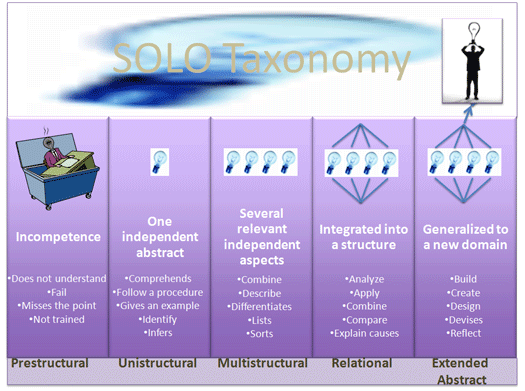
- •Bloom's Taxonomy of Learning Domains
- •The Three Types of Learning
- •Cognitive Domain
- •Table of The Cognitive Domain
- •Bloom's Revised Taxonomy
- •Table of The Revised Cognitive Domain
- •Alternative to Bloom: Structure of Observed Learning Outcome (solo) Taxonomy
- •Affective Domain
- •Psychomotor Domain
- •Other Psychomotor Domain Taxonomies
- •Next Steps
- •References
Alternative to Bloom: Structure of Observed Learning Outcome (solo) Taxonomy
While Bloom's Taxonomy has been quite useful in that it has extended learning from simply remembering to more complex cognitive structures, such as analyzing and evaluating, newer models have come along. IT has also become more useful with the revised taxonomy.
However, one model that might prove more useful is the Structure of Observed Learning Outcome (SOLO) taxonomy. It is a model that describes levels of increasing complexity in a learner's understanding of subjects (Biggs, Collis, 1982). It aids both trainers and learners in understanding the learning process. The model consists of five levels in the order of understanding:
Pre-structural - The learner doesn't understood the lesson and uses a much too simple means of going about it—the learner is unsure about the lesson or subject.
Uni-structural - The learner's response only focuses on one relevant aspect—the learner has only a basic concept about the subject.
Multi-structural - The learner's response focuses on several relevant aspects but they are treated independently—the learner has several concepts about the subject but they are disconnected. Assessment of this level is primarily quantitative.
Relational - The different aspects have become integrated into a coherent whole—the learner has mastered the complexity of the subject by being able to join all the parts together. This level is what is normally meant by an adequate understanding of a subject.
Extended abstract - The previous integrated whole may be conceptualized at a higher level of abstraction and generalized to a new topic or area—the learner is now able to create new ideas based on her mastery of the subject.

SOLO not only shows the instructors how the learners are progressing, but also the learners themselves. This can best be shown by using the square process (start in the inner square):

Affective Domain
T he
affective domain (Krathwohl, Bloom, Masia, 1973) includes the manner
in which we deal with things emotionally, such as feelings, values,
appreciation, enthusiasms, motivations, and attitudes. The five major
categories are listed from the simplest behavior to the most complex:
he
affective domain (Krathwohl, Bloom, Masia, 1973) includes the manner
in which we deal with things emotionally, such as feelings, values,
appreciation, enthusiasms, motivations, and attitudes. The five major
categories are listed from the simplest behavior to the most complex:
|
Category |
Example and Key Words (verbs) |
|
Receiving Phenomena: Awareness, willingness to hear, selected attention. |
Examples: Listen to others with respect. Listen for and remember the name of newly introduced people. Key Words: asks, chooses, describes, follows, gives, holds, identifies, locates, names, points to, selects, sits, erects, replies, uses. |
|
Responding to Phenomena: Active participation on the part of the learners. Attends and reacts to a particular phenomenon. Learning outcomes may emphasize compliance in responding, willingness to respond, or satisfaction in responding (motivation). |
Examples: Participates in class discussions. Gives a presentation. Questions new ideals, concepts, models, etc. in order to fully understand them. Know the safety rules and practices them. Key Words: answers, assists, aids, complies, conforms, discusses, greets, helps, labels, performs, practices, presents, reads, recites, reports, selects, tells, writes. |
|
Valuing: The worth or value a person attaches to a particular object, phenomenon, or behavior. This ranges from simple acceptance to the more complex state of commitment. Valuing is based on the internalization of a set of specified values, while clues to these values are expressed in the learner's overt behavior and are often identifiable. |
Examples: Demonstrates belief in the democratic process. Is sensitive towards individual and cultural differences (value diversity). Shows the ability to solve problems. Proposes a plan to social improvement and follows through with commitment. Informs management on matters that one feels strongly about. Key Words: completes, demonstrates, differentiates, explains, follows, forms, initiates, invites, joins, justifies, proposes, reads, reports, selects, shares, studies, works. |
|
Organization: Organizes values into priorities by contrasting different values, resolving conflicts between them, and creating an unique value system. The emphasis is on comparing, relating, and synthesizing values. |
Examples: Recognizes the need for balance between freedom and responsible behavior. Accepts responsibility for one's behavior. Explains the role of systematic planning in solving problems. Accepts professional ethical standards. Creates a life plan in harmony with abilities, interests, and beliefs. Prioritizes time effectively to meet the needs of the organization, family, and self. Key Words: adheres, alters, arranges, combines, compares, completes, defends, explains, formulates, generalizes, identifies, integrates, modifies, orders, organizes, prepares, relates, synthesizes. |
|
Internalizing values (characterization): Has a value system that controls their behavior. The behavior is pervasive, consistent, predictable, and most importantly, characteristic of the learner. Instructional objectives are concerned with the student's general patterns of adjustment (personal, social, emotional). |
Examples: Shows self-reliance when working independently. Cooperates in group activities (displays teamwork). Uses an objective approach in problem solving. Displays a professional commitment to ethical practice on a daily basis. Revises judgments and changes behavior in light of new evidence. Values people for what they are, not how they look. Key Words: acts, discriminates, displays, influences, listens, modifies, performs, practices, proposes, qualifies, questions, revises, serves, solves, verifies. |
